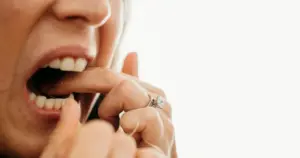Flossing – The how, what, when and why
Flossing is an essential component of oral hygiene, but it’s often overshadowed by brushing. While brushing might feel like it’s enough, flossing is a significant part of maintaining a healthy mouth. Flossing uses a thin filament to remove food particles and plaque from between teeth and under the gumline, areas that might be too cramped or obscured for a toothbrush to reach.
Regular flossing contributes to the prevention of gum disease, bad breath, and dental caries.
For flossing to be effective it needs to be done the right way. Dentists recommend gently guiding the floss between teeth using a rubbing motion and curving it against the base of each tooth, ensuring delicate contact with the gums. Moving in this direction prevents gum injury while making sure hidden debris is completely removed.
The Australian Dental Association recommends flossing at least once a day. The most favourable time to floss is before brushing at night, which helps to ensure that fluoride from the toothpaste can better reach between teeth. Establishing a regular flossing routine is a key factor in optimising dental health.
This article aims to help keep you motivated to look after your smile by understanding the how, what, when and why of flossing your teeth…
Table of Contents
ToggleUnderstanding Flossing
Flossing is a critical element of oral hygiene that involves removing plaque and debris from areas between teeth that a toothbrush cannot reach. It’s essential for maintaining healthy gums and preventing tooth decay. Keeping your gums and teeth healthy is like maintaining gut health, prevention is always better than the cure! The alternative is not nice and can be painful.

Types of Floss
Dental floss comes in various forms, to help cater to individual preferences and needs. The common types include:
- String Floss: Standard floss is a thin strand of nylon that comes in waxed and unwaxed versions. Ideal for its versatility and ability to manoeuvre around the teeth. Waxed string floss slides more easily between tightly spaced teeth, while unwaxed floss can offer a more thorough clean through greater friction.
- Dental Tape: Flatter and broader than standard floss, this is recommended for those with larger gaps between their teeth.
- Super Floss: Suitable for cleaning braces, bridges, and wide gaps. This type of floss has stiffened ends which aid in threading it through the dental work.
- Floss Picks: Good for those who find traditional methods challenging. They are handy for flossing with one hand and can be more convenient when on the go.
- Pre-Threaded Flossers: Helpful for those with limited dexterity. These are small plastic tools with a piece of floss already in place.
It’s essential to choose a type of floss that feels comfortable and makes it easy to reach all areas.
Benefits of Flossing
While brushing cleans the surfaces of your teeth, flossing removes food particles and plaque from between your teeth and under the gumline, areas that a toothbrush can’t reach. Here are a few key benefits of flossing:
- Prevents Gum Disease: Flossing helps remove plaque, a sticky film of bacteria that can accumulate between teeth and along the gumline. If not removed, plaque can harden into tartar, leading to gum inflammation and periodontal disease.
- Reduces Cavities: By removing food particles and plaque from between your teeth, flossing helps prevent the formation of cavities in these hard-to-reach areas.
- Promotes Fresh Breath: Flossing helps remove food debris that can contribute to bad breath.
- Improves Overall Health: Poor oral hygiene is linked to various health issues, including heart disease and diabetes. Flossing contributes to a healthier mouth, which can positively impact your overall health.
Flossing and Oral Diseases
Flossing plays a significant role in preventing oral diseases:
- Gingivitis: Caused by plaque build-up, flossing can prevent this inflammation of the gums.
- Periodontitis: Advanced gum disease can be kept at bay with thorough plaque removal.
- Tartar: Flossing helps prevent plaque from hardening into tartar, which can lead to more serious dental issues.
Effective flossing that targets the gum line and spaces between teeth is pivotal in combating oral diseases. When you don’t maintain your teeth and gums, it can end up with problems and infections. If you don’t get your annual check-up, brush and floss regularly, it could end up with you needing a root canal or you could lose a tooth!

Best Practices and Common Mistakes
Flossing is an essential part of maintaining good oral hygiene, but it’s important to do it correctly to reap the full benefits. Here are some best practices and common mistakes to be aware of to ensure you’re flossing effectively and protecting your teeth and gums.
Proper Flossing Techniques
Flossing typically takes about two to three minutes once you become proficient at it. Initially, it might take a bit longer as you get used to the technique, but with practice, you can effectively clean between all your teeth within this time frame.
Basic Flossing Steps
1) Choose the Right Floss:
Select a type of dental floss that you find comfortable. There are various options, including waxed, unwaxed, flavoured, and tape floss.
2) Break off a Piece of Floss:
Cut about 45 cm of floss. This length allows you to use a clean section of floss for each tooth.
3) Hold the Floss:
Wind most of the floss around the middle finger of one hand, and a small amount around the middle finger of the other hand. Use your thumbs and index fingers to hold the floss taut, with about 2-3 centimetres of floss between them.
4) Guide the Floss Between Your Teeth:
Gently guide the floss between your teeth using a gentle sawing motion. Avoid snapping the floss into your gums, as this can bruise or injure delicate gum tissue.
5) Form a C Shape:
Once the floss is between your teeth, curve it into a C shape around one tooth. Slide it up and down against the side of the tooth and under the gumline. Be sure to go beneath the gumline, but avoid forcing the floss.
6) Repeat for Each Tooth:
Use a clean section of floss for each tooth. Unwind a fresh section from one hand and wind the used section onto the other hand as you move from tooth to tooth.
7) Remember the Back Teeth:
Make sure to floss the back sides of your last molars, as these areas are often neglected.
8) Rinse Your Mouth:
After flossing, rinse your mouth with water or mouthwash to remove any dislodged food particles and plaque.
Top Tips for Effective Flossing
- Be Gentle: Avoid snapping or forcing the floss, which can damage your gums.
- Consistency is Key: Floss at least once a day to maintain optimal oral health.
- Use Alternatives if Needed: If traditional floss is difficult to use, consider floss picks, interdental brushes, or water flossers as alternatives.
Flossing with Braces
Flossing with braces requires more care and the use of special tools like floss threaders. A floss threader is a flexible device that helps carry the floss behind the braces wire. Pass a short length of floss through the threader and slide the point under the archwire of the braces. Pull the floss through and then follow the basic flossing steps. Use a gentle touch to avoid damaging the wires and brackets. Interdental brushes may also be used to clean between the braces and teeth.
Common Flossing Errors
Common errors that can limit the effectiveness of flossing:
- Not enough Floss: Using a short piece of floss can make it difficult to use a clean section for each tooth, reducing effectiveness.
- Forcing the Floss: Forcing the floss between teeth can injure your gums, leading to bleeding and discomfort.
- Inconsistent Flossing: Infrequent flossing can lead to plaque buildup and gum disease. Consistency is key for maintaining oral health.
- Skipping Teeth: All teeth, including the back ones, require flossing to prevent plaque buildup and gum disease.
- Flossing Too Hard: Being too aggressive can damage the gums, leading to bleeding and swelling. Gentle and steady motions are the most beneficial.
- Not Flossing Long Enough: Each space between teeth should be cleaned with a fresh section of floss to avoid redistributing food particles and bacteria.
- Incorrect Technique: The floss should curve around the tooth in a ‘C’ shape and gently move up and down, rather than sawing back and forth, which can cause bruising.
Regular flossing, when done properly, prevents gum disease, tooth decay, and can even reduce bad breath.
Flossing and Overall Health
Flossing plays a pivotal role in maintaining oral hygiene and overall health. Regular removal of food particles and debris from between teeth with floss helps to prevent tooth decay and gum disease.
Gum disease, if left unchecked, can contribute to more severe health issues including heart disease and diabetes. Bacteria from inflamed gums can enter the bloodstream, potentially leading to arterial inflammation.
Frequent flossing also counteracts bad breath by eliminating the remnants of sugary foods and trapped particles that can decompose and release unpleasant odours.
There are all kinds of floss available from the simple string floss to high pressure water flossers. These flossers can make it a bit easier and faster to get to all the parts of your mouth so talk to the team at Ultra Dental and work out the best solution for you and what you prefer!
To get the full benefits of flossing practice and perfect the correct technique once a day, preferably each night as part of a regular, consistent brushing routine. Dentists and dental hygienists can provide guidance on proper flossing methods to ensure that the process is both effective and gentle on the gums.

